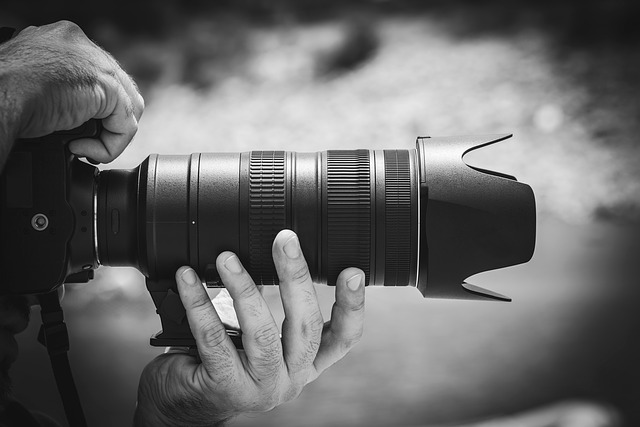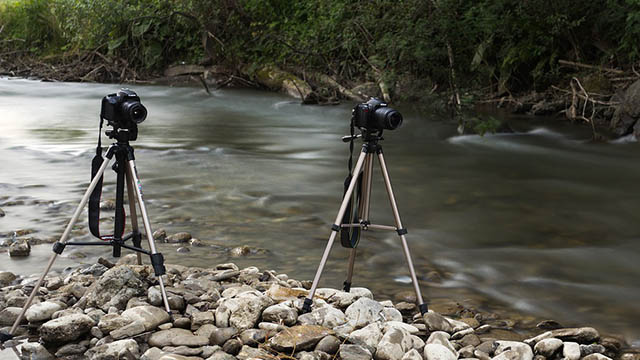The ideal photographic equipment for interior photography
Full Frame Camera
To professionally photograph real estate, you need to purchase a full frame camera. The latter has a larger sensor than entry level or compact digital cameras. There are different types (from classic SLRs to mirrorless) and it’s up to the photographer to decide which is best for your needs. The reflex is one of the most used despite having a large body and a considerable weight, for this reason some prefer to focus on mirrorless to take advantage of an unparalleled lightness.
Studio flash

Studio flashes are more powerful flashes than hotshoes, they allow you to mount light modifiers, in a simpler way, and can be the sacred grail of a hotel photographer.
The value of studio flashes is their power and the quality of light they can provide (through different light modifiers). The negative factor is that it takes a long time to set everything up but the result is definitely worth it, especially for shooting in particular environments, not very bright or that need to photograph people, such as in hotels.
Studio flashes can be particularly useful in all those rooms that have different amounts of light, for example houses with many windows or fully open lofts, which could complicate a photographer’s life. In fact, the risk is to perfectly represent a part of the room and leave another area completely illuminated and “burned”.
Conversely, if you balance half of the lighted room well, the other half will be completely dark or too dark. These cases should never be underestimated because they could make the difference in a professional shooting. In this regard, a studio flash can quickly resolve the situation and give a coherent and well-lit view of the entire area.
The best shooting angle
In all these types of photographs it is necessary to study the best shooting angle or the right angle to beautify a room and not mortify the merits. After this phase it will be possible to move the objects, use softer lights, add decorative elements that soften the overall style and make it more attractive.
First of all you should take a tour inside the environment you need to photograph, and look through the camera, which angle strikes you most, which best enhances the subject you are photographing, whether it is a hotel room, a large kitchen a house to sell or any other real estate entity.
The full frame format is certainly fuller, sharper and more detailed as well as having a high quality that will make the photos look like those in design magazines. A good sensor is also ideal for facilitating photographic work, especially in difficult contexts. This can be translated into better light management. You may think that a full frame is too expensive but the reality is changing.
More and more manufacturers are producing cheaper full frame versions to fill this gap in the market. The amateur photographer can buy a professional camera without sacrificing too much his wallet.
Obviously one of the most important factors remains the wide choice of interchangeable lenses, the latter completely change the approach to shooting and a good indoor photographer needs various types depending on the environment to be photographed.

Recommended photo lenses for interior photography
Choosing a lens is important because it represents the eye of the camera. The image will be recorded and packaged according to the lens used so do not underestimate this choice. One of the best lenses for interior photography is the wide angle but be careful, it is not too extreme.
The pushed wide angle has the advantage of representing the whole room and making it seem wider but excessively distorts the scene and, consequently, both magazines and hotels may not accept the shots as they are too confusing (some furniture magazines do not publish photographs shot with a wide angle under 24mm!).
An excellent wide angle is the one with a field of view of no less than 24 mm (on full frame model) in order to represent the room without changing its characteristics. The latter are fixed objectives, in some respects limited as it is practically impossible to approach or leave the scene by turning the ring.
The advice for simplicity and practicality is to prefer the zoom to enjoy a certain versatility, but the 50mm or 100mm, can be useful in different cases, especially for details and close-up shots. To photograph details, a 50mm or 100mm may also be useful.
Is the tripod important?
The tripod is one of the most influential photographic accessories for interior photography. A good tripod is made of solidity and stability and that is precisely why you shouldn’t save, rather better if you buy a less expensive lens and focus everything on the tripod.
Some hotel photographers may wonder why you cannot simply use a manual shot but the reason is that often the shooting points are very high and it is therefore necessary to rely on a tripod to simplify the operation. Not to mention that it will be a more detailed photo thanks to the absence of the annoying blur given by gestures, breathing, etc.
Head for the tripod
There are different types of tripod heads depending on the use to be made of them, some can cost over € 1000 but this is not the case. The three-way head is one of the most suitable for indoor photography. It has a lever that moves the head of the tripod following specific axes and offering a control that goes from top to bottom, from bottom to top and sideways.
In this way the real estate photographer will have a good dexterity and choice of angles, without having to force his hand or continuously assemble the structure. Surely it is not ideal for a quick and fast shooting as it is very cumbersome and requires time because the 3 locking levers are larger than the norm.

Even if the ideal is to work with natural light it is not always possible and it is not always the best solution for real estate photography; there are very dark rooms that need a hotshoe flash to illuminate the various parts, or there are rooms that have particular lighting situations, which can be easily solved with a simple hotshoe flash.
We talk about hotshoe flashes all those external flashes that are left to slide on a metal rail placed on the full frame. If you’re thinking of using the small built-in flash in your camera, get the idea straight away, unless you’re a black belt in flash management. An integrated flash has a mediocre and limited range, and must be used wisely to make the most of it.
If you want to use light wisely it is necessary to learn how to use an external flash, in order to eliminate some difficulties such as very hard lights, excessively strong light, flattening of the scene. The advantage of the hotshoe flash is that it is very small, light and handy. Always carry one inside the structure and if there is a need to use it. It works with batteries, so it does not need electricity and has a good duration.
For the management of the lights, we recommend that you take a course, study a special photography book or practice at home to better juggle the technique as it is not easy.


